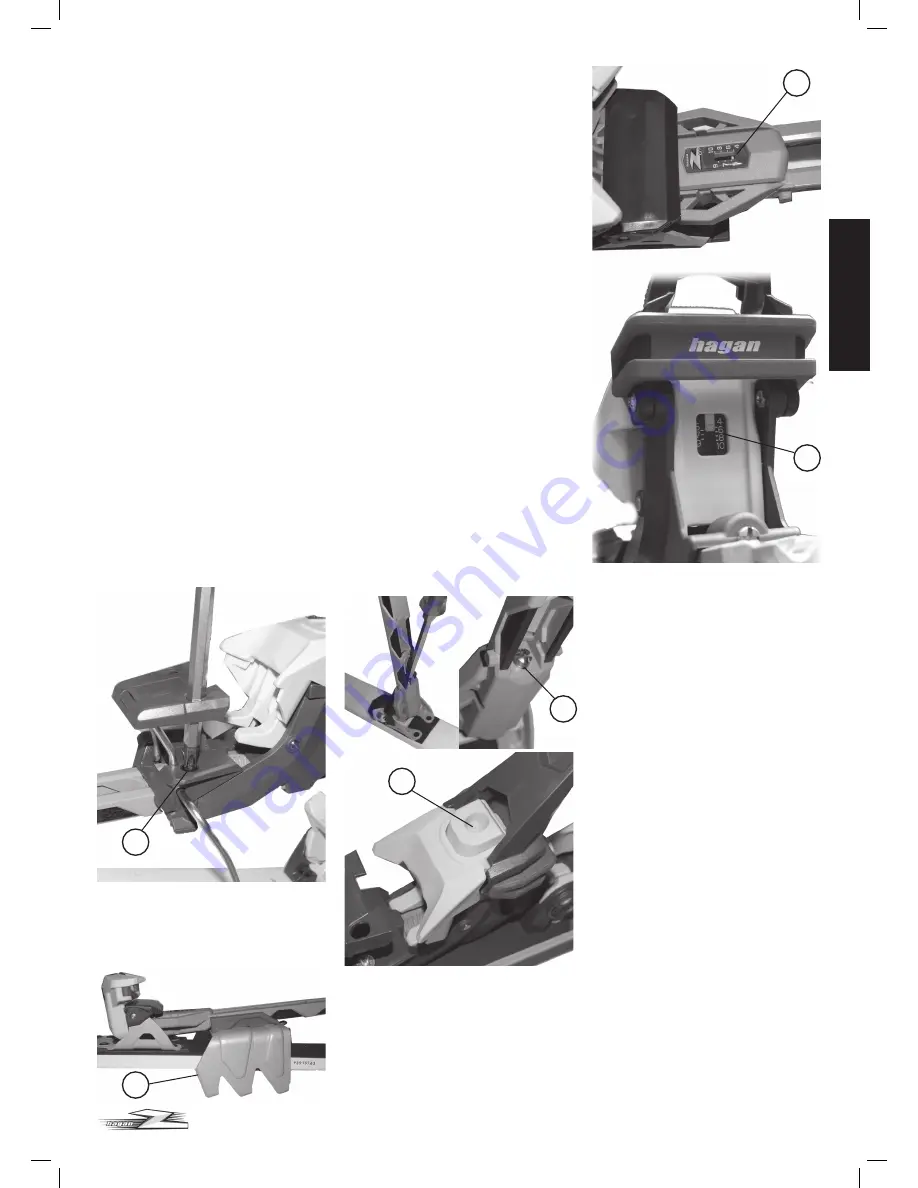
08/10 © Hagan Ski GesmbH, Andiesen 11, 4774 St.Marienkirchen, Austria / Art. Nr. TU055-H
ENGLISH
with the crampon mounting points
(19) of the binding frame (13). Now
push the crampon-locking lever (33)
upward until it locks. Dismount in the
reverse order.
3.15 General operation of the binding:
See user manual client
. Release value selection and
adjustment
Only use the DIN/ISO recommended
release values! Only use the chart
attached below or the official standard-
adjustment charts to calculate the right
release value for the specific skier.
• Each modification or personal adjust-
ment can be hazardous!
• The adjustment is carried out via the
adjustment screws (3+6)
• The adjustment value is visible on the Z-
value adjusting scale (4+5). Always set
front and toe piece on the same values.
• We strongly recommend to double
check the release value on a speci-
fic binding test device (compare ISO
11110)
• The release value have to be evaluated
for each skier by a specialized retailer,
in order to find the right adjustment
according to DIN/ISO 11088
• All specifications and the adjusted Z-
value have to be entered in a certificate
and be handed out to the client along
with the owner’s manual.
.1 Categorization of the skier
according to the weight method
Required information of the skier:
• Weight
• Height
• Age
• Sole length
• Skier type
This classification for a skier’s type has to
be evaluated in a conversation between
retailer and skier in order to find out the
parameters for the setting of the binding.
The parameters are the following:
Skier type 1:
• Skis without taking risks
• Prefers moderate speed
• Prefers easy, moderate terrain
• Has a basic skiing knowledge and little
shape
• For good skiers with a moderate and
mellow style, preferring to on the safe
side
• Uses a lower Z-setting. The risk of
unintended releases is higher, but the
binding releases in any case, even in a
slight fall.
Skier type :
• Has a basic skiing knowledge and good
shape
• Skis at varying speeds
• Skis every terrain, even difficult slopes
• Applies to every skier who is not cate-
gorized in any of the other types
through this gap between the sole
and gliding AFD).
Caution:
The toe sole holder screw may
only be operated with a hand screw-
driver! If the sole is too thick a not
standardized, it cannot be fitted in
as described. In this case you have
to grind the sole down as far as the
above mentioned paper stripe test
can be realized.
3.11 Height adjustment of the heel cup
The heel cup (7) adjusts to the height
of the boot heel by itself!
3.12 Check whether the boot is held in the
binding without any clearance. There-
fore you have to turn the boot upward
and sideways by hand.
3.13 Ski brake:
The hagan ski brake is supplied with
a ski brake for a maximum waist width
of 80mm ex works! Additional options
are ski brakes with a waist width of
90, 100 and 115mm.
Mounting and exchange of this
optional brake widths: Loosen the
screws (22), exchange the whole
brake against the optional, new one
and then tighten the screws again
by
hand!
Check: The brake levers have to move
freely along the sidewalls of the ski. If
they touch the sidewalls slightly, you
can carefully bend the levers apart
until they have the desired width.
3.14 Crampons:
Pivot the crampon (30) onto the bind-
ing frame from the bottom up and
slide it forward until the cutouts within
the crampon adapter (31) connect
22
30
3
6
4
5
























